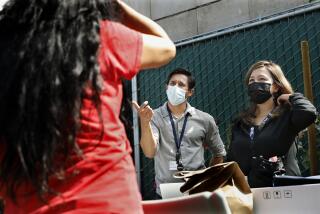Poll Finds Teenagers Unaware of Methamphetamine Risks
- Share via
A majority of teenagers in Los Angeles County say they don’t believe there is any risk in trying the drug methamphetamine once or twice.
That’s one of the unsettling findings of a survey to be released today by the Partnership for a Drug-Free America at a Universal City hotel. The study’s results spurred a new anti-methamphetamine advertising campaign aimed at teenagers.
Teenagers’ use of methamphetamine, also known as speed, is not high. About 10% of youngsters in Los Angeles and 9% nationwide reported that they had used it at least once over the previous year, according to the survey.
Still, receptiveness to the drug is a warning “on where behavior will go,” Steve Dnistrian, senior vice president of the New York-based Partnership, said Tuesday.
“Are kids hearing the dangers about this drug or missing it? To a great degree, they are missing it and that’s disturbing,” he said.
The anonymous survey last year of 5,536 Los Angeles County students in the seventh through 12th grades proved to be especially worrisome because methamphetamine is so readily available in Southern California, from both small-time home labs and big manufacturing operations hidden in desert areas, officials said.
The poll showed a great split in attitudes between youngsters and their parents. Fifty-eight percent of teenagers in Los Angeles and 56% nationally did not believe that trying methamphetamine posed a big risk. Los Angeles parents were not polled. But, in a nationwide sample, 79% of parents greatly feared that just one try would harm their children.
The poll results did not surprise William Smith, director of clinical services for Phoenix Houses of California, which has seven substance-abuse treatment centers.
“I think young people basically have a tendency to want to experiment with things to some degree,” he said. “In spite of information that’s available, they always feel it’s not going to happen to them.” Methamphetamine use seems particularly strong in San Diego County, probably because of the large number of illegal labs there, Smith said.
Described as the cocaine of the ‘90s, methamphetamine is a white or yellowish substance in powder or rock form that is smoked or injected. It can trigger psychoses and violent behavior and, experts stress, can be quickly addicting.
Emergency rooms nationally and in Los Angeles said methamphetamine-related episodes more than doubled between 1991 and 1996, according to the Partnership.
Federal investigations into methamphetamine production have increased “tenfold” over the past two years, said Robert Bender, special agent in charge of the Drug Enforcement Administration’s Los Angeles office. Although Southern California has been the methamphetamine capital of the country, the drug has spread with a vengeance to the Midwest because profits on manufacturing and sales can be so high, he said.
Bender is scheduled to be among the officials at the Sheraton Universal today for the unveiling of new anti-methamphetamine ads that are part of a campaign coordinated by the White House. Some of the ads will dramatize the vivid hallucinations of methamphetamine abusers, such as bugs crawling over and inside their skin.
About half of the Los Angeles teenagers who reported regular methamphetamine use were female, compared to only 36% around the country, the survey found. Forty-six percent of regular teenage users were said to be 15 or younger in Los Angeles, while 53% nationally were. And Latinos comprised the majority of teenage “speeders” in Los Angeles, with whites the majority across the United States.
In other results, the Partnership poll found that 34% of the Los Angeles teenagers reported having smoked marijuana at least once in the previous year, 9% tried crack cocaine and 15% snorted an inhalant.
More to Read
Sign up for Essential California
The most important California stories and recommendations in your inbox every morning.
You may occasionally receive promotional content from the Los Angeles Times.














